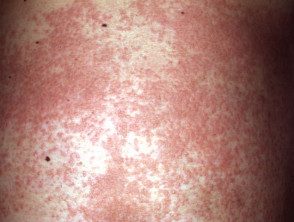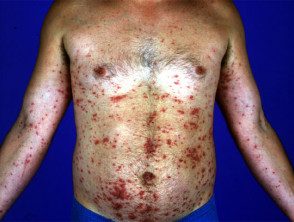What is it disseminated secondary eczema?
Secondary disseminated eczema is a acute, generalized eczema/dermatitis that arises in response to a previous located inflammatory Skin illness.
Also called id reaction, autosensitization dermatitis and autoeczematization.
Disseminated secondary eczema

Disseminated secondary eczema

Disseminated secondary eczema
What causes secondary disseminated eczema?
The cause of secondary disseminated eczema is unknown. Theories have suggested that it is an immune response to some component of the skin and/or to circulating infectious agents or cytokines (messenger proteins).
Who gets secondary disseminated eczema?
Secondary disseminated eczema can occur in children and adults, but is most often diagnosed in the elderly with carelessness. primary eruption in the lower leg
The most common types of eczema/dermatitis that precede secondary disseminated eczema, an eczematide, are:
- Chronic venous eczema
- Acute contact eczema
- Acute or chronic discoid eczema
Infections that precede secondary disseminated eczema include:
-
Mushrooms infection, for example, inflammatory tinea pedis or animal kerion: a dermatophytid
- Bacterial infection, for example, wound infection or thermal burn, a bacteria
-
Viral infection, e.g. Ex. Molluscum contagiosum
- Arthropod infestation p. e.g. scabies or lice: a pediculide
What are the clinical characteristics of secondary disseminated eczema?
Secondary disseminated eczema presents as an acute, symmetrical, acute generalized eczema. It tends to itch extremely, disturbing sleep.
- The forearms, legs, thighs, and trunk are commonly affected.
- Appearance varies and includes blisters, bumps, scabs plates (discoid eczema), follicular papules, morbilliform eruption, targettoid lesions and pompholyx (blisters on palms and soles).
- Occasionally, the patient may feel unwell with fever and loss of appetite.
Not-eczematous identification reactions include erythema noddy, sweet syndrome, guttate psoriasis and blisters.
How is secondary disseminated eczema diagnosed?
The clinical features of secondary disseminated eczema are characteristic. Finding the cause depends on taking a careful history of the initial site of a skin problem. Sometimes the patient does not associate a minor chronic rash with his current extended and symptomatic rash.
Additional investigations that may be considered include:
-
Dermoscopy of hair Shafts for nits (lice) and burrows for scabies Mites
- Swabs from crusty areas or pustules for bacteriology
- Scrapping of scaly cancel or hairless plates for mycology
- Skin biopsy from elementary school injury and/or secondary rash (histology it is spongy dermatitis)
- Blood count in a sick patient
- Reference for patch tests, if there is suspicion of contact allergy
Patch testing should not be performed during the acute phase of secondary disseminated eczema, but can be planned in several months when it has resolved.
What is the treatment for secondary disseminated eczema?
The primary rash should be treated vigorously. This may require systemic therapy, p. e.g. antibiotics for bacterial or oral antifungals for confirmed dermatophytids.
Secondary eczema is often extensive and highly symptomatic. Treatment may involve:
- Referral for specialist evaluation and treatment, including hospital admission.
-
Wet wraps or dressings for weeping eczematous plaques
-
Potassium permanganate 1:10,000 dips for localized exudation, infected areas
- Powerful current corticosteroid creams for 1-3 weeks
-
Systemic corticosteroids, for example prednisone or prednisolone for several weeks.
- Oral sedative antihistamines at night
